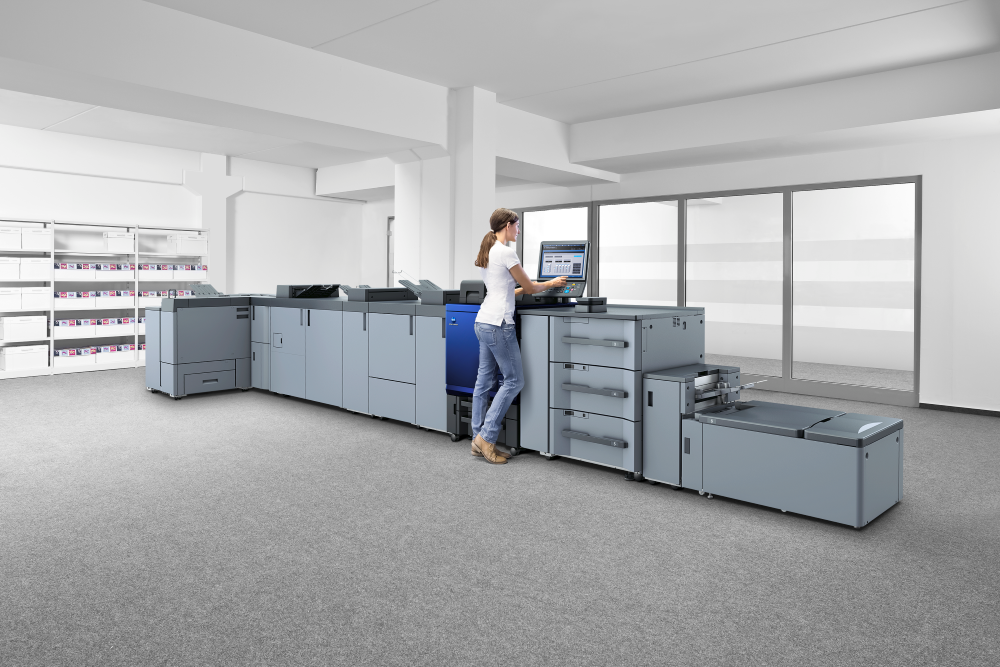Production printing, the process of producing large volumes of high-quality printed materials, is undergoing significant transformation. Innovations in this field are driven by technological advancements, market demands, and the push for sustainable practices. These developments are revolutionizing industries such as publishing, packaging, and commercial printing. Here are some key trends to watch in the world of production printing:
1. Digital Printing Advancements
Digital printing technology continues to evolve, offering many benefits over traditional offset printing. Key advancements include:
High-Speed Inkjet Printing: Modern high-speed inkjet printers deliver faster print speeds and superior image quality, making them ideal for large-scale production.
Enhanced Colour Management: Advanced colour management systems ensure consistent and accurate colour reproduction, meeting the stringent demands of brand owners.
Variable Data Printing: Digital printing enables personalised and customised prints with variable data, catering to marketing campaigns and personalized products.
2. Sustainable Printing Solutions
Sustainability is a critical concern in production printing. Innovations in this area aim to reduce environmental impact and promote eco-friendly practices:
Recyclable and Biodegradable Materials: Use of sustainable substrates, such as recyclable and biodegradable papers and plastics, is increasing.
Eco-Friendly Inks: Water-based and vegetable-based inks are replacing traditional petroleum-based inks, reducing harmful emissions.
Energy-Efficient Equipment: New printing presses are designed to be more energy-efficient, lowering the carbon footprint of production facilities.
3. Integration of Automation and AI
Automation and artificial intelligence (AI) are streamlining production printing processes, enhancing efficiency, and reducing labour costs:
Automated Workflow Systems: Integrated workflow solutions automate tasks such as file preparation, colour correction, and print scheduling, minimising manual intervention.
AI-Driven Quality Control: AI systems monitor print quality in real-time, detecting and correcting defects to ensure consistent output.
Predictive Maintenance: AI algorithms predict equipment failures before they occur, enabling proactive maintenance and reducing downtime.
4. Advanced Finishing Techniques
Innovations in finishing techniques are enhancing the final appearance and functionality of printed materials:
Digital Embellishments: Techniques such as digital foiling, embossing, and varnishing add tactile and visual appeal to printed products without the need for traditional dies and plates.
Hybrid Printing: Combining digital and traditional printing methods allows for creative effects and high-quality finishes.
Smart Packaging: Incorporating technologies like QR codes, NFC tags, and augmented reality into printed packaging provides interactive and engaging experiences for consumers.
5. On-Demand and Short-Run Printing
The demand for on-demand and short-run printing is rising, driven by the need for flexibility and cost-efficiency:
Print-on-Demand Services: These services allow businesses to print materials as needed, reducing inventory costs and waste.
Short-Run Production: Advances in digital printing make it economically viable to produce small quantities of high-quality prints, catering to niche markets and limited-edition products.
Just-in-Time Production: Printing only what is needed, when it is needed, aligns with lean manufacturing principles and reduces excess inventory.
6. Integration with Digital Platforms
The integration of production printing with digital platforms is creating new opportunities for cross-media marketing and enhanced customer experiences:
Web-to-Print Solutions: Online platforms allow customers to design, customize, and order printed materials directly, streamlining the ordering process.
Cross-Media Campaigns: Integration with digital marketing channels enables coordinated campaigns across print, email, social media, and more.
Augmented Reality (AR): Printed materials with AR capabilities provide interactive and immersive experiences, bridging the gap between print and digital media.
The future of production printing is bright, characterised by rapid technological advancements and a strong focus on sustainability and efficiency. By embracing these innovations, businesses can stay ahead of the competition, meet evolving customer demands, and achieve higher levels of productivity and quality. As these trends continue to develop, production printing will remain a vital and dynamic industry, driving growth and innovation across various sectors.





